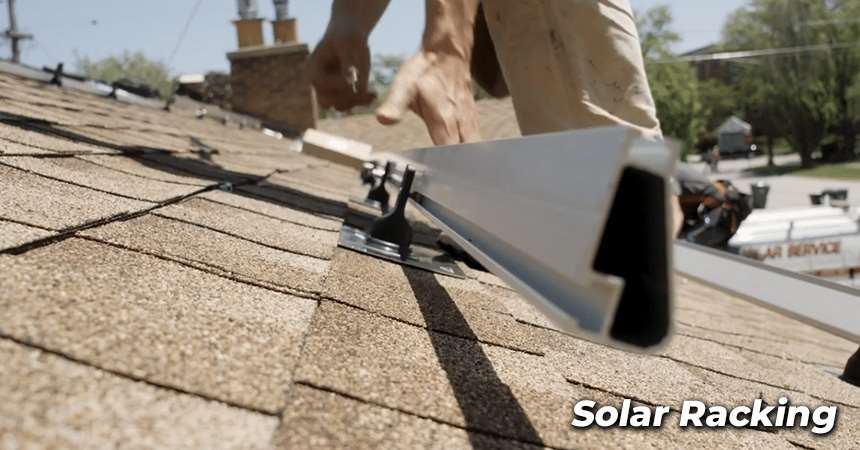Solar Racking: An In-Depth Look at the Backbone of Solar Systems

Solar Racking: An In-Depth Look at the Backbone of Solar Systems
What is Solar Racking?
Solar installation companies utilize solar racking products, also known as solar mounting, to securely attach solar panels to buildings or the ground. These products are designed to hold the solar equipment in place in an installation. Typically, solar racking is constructed using aluminum because it offers a favorable combination of strength and low weight, making it an ideal choice for rooftop installations, when compared to other metals.
What Components Makes Up Solar Racking?
1. Flashings
To install solar panels on a roof, it is necessary to drill holes that can potentially cause leakage if not adequately sealed. Solar installers typically incorporate flashing into their solar mounting solution to prevent water damage to your property. Flashing is a material used to obstruct water from infiltrating your roof, commonly in the form of an aluminum rectangle. On a conventional asphalt shingle roof, flashing is placed beneath the shingles. However, for roofs constructed of tile, metal, rubber, or wood, there are customized flashings that fit the distinct shape of the roofing material. When installed correctly, the flashings create a water-tight seal on your roof for the lifetime of your solar system.
2. Mounts
Solar panel systems are affixed to roofs with mounts, also known as "feet." These mounts are typically secured to the roof using a bolt that goes through the flashing and into a rafter, thereby stabilizing the entire system. Various types of mounts are employed in different racking systems. During an initial site visit, solar installers require access to your attic or the underside of your roof to verify that the rafters are structurally sound and adequately spaced to accommodate the mounts for your solar panel system.
3. Rails
Rails are the foundational element of solar racking, serving as the base for mounting your solar panels. Typically made of lengthy aluminum tracks, they can be installed vertically or horizontally on your rooftop. Alternative rail setups like rail-less or shared-rail systems are also available. Rails offer an extra advantage by creating an unobstructed pathway behind the panels for wiring, contributing to a cleaner and safer installation with better aesthetics.
4. Clamps
To ensure that solar panels remain firmly fixed to the racking, installers utilize clamps that connect the solar modules to the underlying rails. Typically, both mid-clamps and end-clamps are utilized in an installation. Mid-clamps are positioned between the solar modules and can secure panels on two sides, whereas end-clamps are situated at the ends of solar arrays and are generally larger in size.
Finding the Right Angle For Solar Panels
Pitched Roofs
The majority of residential installations are done on pitched roofs. Solar systems are typically placed in parallel with the roof on slanted roofs, maintaining a few inches of space between the mounting hardware and the solar PV panels. When the gap is too narrow, it can impede proper airflow, leading to overheating of the solar panels and a decrease in electricity production.
Flat Roofs
On flat roofs, PV panels are frequently positioned at a steeper angle than the roof's inclination, thanks to the racking system. Some clients may prefer to avoid piercing their roof. In such situations, a ballasted system could be a suitable alternative. These systems utilize concrete blocks to hold the system in place rather than fastening it down to avoid being lifted by the wind.
Ground Mounts
In some instances, it may not be feasible to install the solar system on the rooftop. While it is typically the most cost-effective option, it may not be advisable or possible. For instance, if the roof is extensively shaded or in poor condition, a ground mount may be a better alternative.
These racking systems typically elevate the panels to a favorable angle to avoid shading and maximize solar electricity production. Additionally, pole mounts enable the system to track the sun's movement.
How Do Racking Costs Differ?
Rooftop solar systems can incur an additional cost of 10% due to rooftop racking, amounting to approximately $40 to $80 per panel, excluding installation fees. On the other hand, racking hardware for ground-mounted frame systems can cost $60 to $100 per panel. However, the installation of a ground-mounted system entails additional expenses for piping and concrete, which could potentially double the total cost.
Among all options, a pole-mounted system with trackers is the most expensive, with costs that can go up to twice that of a ground-mounted frame system. Nevertheless, the greater solar panel efficiency achieved by using trackers may offset the added initial expenses.
Popular Solar Panel Racking Solutions
Although there are numerous solar racking manufacturers, below are three popular brands that lead the way for excellent PV racking solutions.
UNIRAC
UNIRAC has several product lines, all catering to different installer preferences for residential and commercial solar panel systems. UNIRAC is North America’s leading manufacturer of solar PV mounting systems, roof attachments, roof flashings, and accessories. With more than 22 years of customer service, UNIRAC has over 8GW of experience and more than 1,000,000 installations worth of knowledge.
Unirac enables its customers to power the world with clean, abundant energy by creating dependable, innovative mounting solutions. They are headquartered in New Mexico.
IronRidge
Generally thought of as making some of the physically toughest racking equipment, Ironridge is another popular solar racking manufacturer. They offer pitched roof, flat roof, and ground-mounted racking solutions. Their products range from moderate to extreme load capabilities, and they are known for producing some of the strongest racking systems in the industry. This is especially helpful in extreme climates with large snow loads or high wind loads.
All IronRidge systems come with a 25-year warranty, and are listed under UL2703, the standard for evaluating the efficacy of mounting systems as they relate to electrical and mechanical connections.
Ironridge is based in California, and has been operational since the mid-1990s.
SnapNRack
SnapNRack is a solar racking company based in California that specializes in making a snap-in racking solution. Their Ultra Rail Roof mounting system uses snap-in brackets for attaching rails, making any installation easy.
With this system, it is easy to mix module orientation for greater energy production. The company is owned by SunRun and produces residential roof and ground-mount racking systems, but not commercial PV racking.
Viridis Energy Knows Solar Racking
To guarantee a safe and successful installation, solar panel mounting should only be performed by a professional installer like Viridis Energy. If you're ready to find the right equipment for your home solar panel installation, talk to Viridis Energy today.
To schedule a virtual or in-home appointment, homeowners can fill out the form below.
SEE HOW MUCH YOU CAN SAVE BY GOING SOLAR
CALCULATE YOUR SAVINGS
